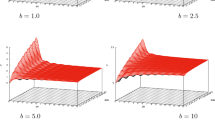Abstract
The beta regression model is the commonly used approach for modeling data in the unit interval. However, there are in the literature some useful and interesting alternatives which often under-used. This paper proposes a novel regression model for bounded data, where the response variable is complementary beta distributed with mean and dispersion parameters. The proposed regression model is a natural strong competitor of the beta regression model. The maximum likelihood method is used for estimating the model parameters. A Monte Carlo experiment is conducted to evaluate the performances of these estimators in finite samples. The usefulness of the new regression model is illustrated by two real applications.








Similar content being viewed by others
References
Akaike H (1974) A new look at the statistical model identification. IEEE Trans Autom Control 19(6):716–723
Atkinson A (1985) Plots. transformation and regression. Clarendon Press, Oxford
Atkinson AC (1981) Two graphical displays for outlying and influential observations in regression. Biometrika 68(1):13–20
Cepeda-Cuervo E (2001) Variability modeling in generalized linear models. Ph.D. thesis, Mathematics Institute, Universidade Federal do Rio de Janeiro
Cox DR, Hinkley DV (1979) Theoretical statistics. CRC Press, Boca Raton
Dixon AC (1902) Summation of a certain series. Proc London Math Soc 35(1):284–291
Dunn PK, Smyth GK (1996) Randomized quantile residuals. J Comput Gr Stat 5(3):236–244
Ferrari S, Cribari-Neto F (2004) Beta regression for modelling rates and proportions. J Appl Stat 31(7):799–815
Gradshteyn I, Ryzhik I (1994) Table of integrals, series, and products. Academic Press, Cambridge
Gupta AK, Nadarajah S (2004) Handbook of beta distribution and its applications. CRC Press, Boca Raton
Hannan EJ, Quinn BG (1979) The determination of the order of an Autoregression. J R Stat Soc Ser B (Methodol) 41(2):190–195
Held L, Sabanés Bové D (2014) Applied statistical inference - likelihood and bayes. Springer, Ney York
Hosking JRM (1990) L-Moments: analysis and estimation of distributions using linear combinations of order statistics. J R Stat Soc Ser B (Methodol) 52(1):105–124
Hosking JRM (1992) Moments or L Moments? An example comparing two measures of distributional shape. Am Stat 46(3):186–189
Iacobellis V (2008) Probabilistic model for the estimation of T year flow duration curves. Water Resour Res 44(2):02413
Johnson NL, Kotz S, Balakrishnan N (1995) Continuous univariate distributions, vol 2, 2nd edn. Wiley, New York
Jones MC (2002) The complementary Beta distribution. J Stat Plan Inference 104(2):329–337
Jones MC (2018) Families of complementary distributions. Stat Probabil Lett 141:74–81
Jorgensen B (1997) The theory of dispersion models. Chapman & Hall, USA
Kamps U (1991) A general recurrence relation for moments of order statistics in a class of probability distributions and characterizations. Metrika 38:215–225
Kieschnick R, McCullough BD (2003) Regression analysis of variates observed on (0, 1): Percentages, proportions and fractions. Stat Modell 3(3):193–213
Lemonte AJ, Bazán JL (2015) New class of Johnson distributions and its associated regression model for rates and proportions. Biometrical J 58(4):727–746
Mazucheli J, Menezes AFB, Chakraborty S (2019) On the one parameter unit-Lindley distribution and its associated regression model for proportion data. J Appl Stat 46(4):700–714
Mazucheli J, Menezes AFB, Fernandes LB, de Oliveira RP, Ghitany ME (2019) The unit-Weibull distribution as an alternative to the Kumaraswamy distribution for the modeling of quantiles conditional on covariates. J Appl Stat 47:954
McCullagh P, Nelder J (1989) Generalized linear models, 2nd edn. Chapman and Hall, USA
Menezes AFB, Furriel WO (2019) Beta and Simplex regression models in the analysis of the municipal human development index 2010. Rev Bras Biom 37(3):394–408
Mitnik PA, Baek S (2013) The Kumaraswamy distribution: median-dispersion re-parameterizations for regression modeling and simulation-based estimation. Stat Papers 54(1):177–192
Nadarajah S, Kotz S (2007) Multitude of Beta distributions with applications. Stat: J Theor Appl Stat 41(2):153–179
Neyman J, Pearson ES (1928) On the use and interpretation of certain test criteria for purposes of statistical inference. Biometrika 20A(1/2):175–240
SAS, 2010. The NLMIXED Procedure, SAS/STAT® User’s Guide, Version 9.4. Cary, NC: SAS Institute Inc
Schwarz G et al (1978) Estimating the dimension of a model. Annals Stat 6(2):461–464
Smithson M, Verkuilen J (2006) A better lemon squeezer? maximum-likelihood regression with beta-distributed dependent variables. Psychol Methods 11:54–71
Zhang P, Qiu Z, Shi C (2016) Simplexreg: an R package for regression analysis of proportional data using the Simplex distribution. J Stat Softw 71(11):1–21
Author information
Authors and Affiliations
Corresponding author
Additional information
Publisher's Note
Springer Nature remains neutral with regard to jurisdictional claims in published maps and institutional affiliations.
Rights and permissions
About this article
Cite this article
Menezes, A.F.B., Bourguignon, M. & Mazucheli, J. Complementary Beta Regression Model for Fitting Bounded Data. J Stat Theory Pract 16, 25 (2022). https://doi.org/10.1007/s42519-022-00256-w
Accepted:
Published:
DOI: https://doi.org/10.1007/s42519-022-00256-w




